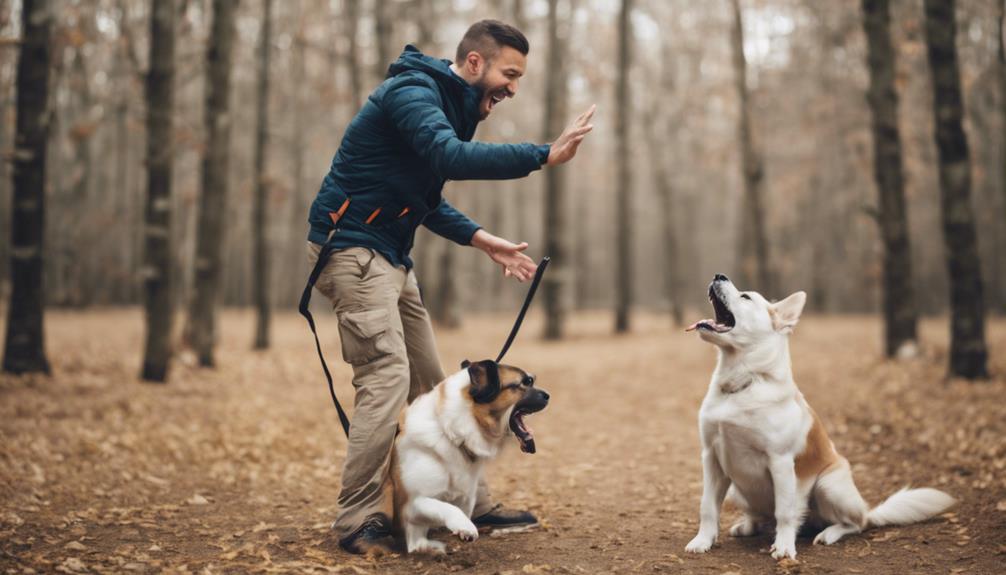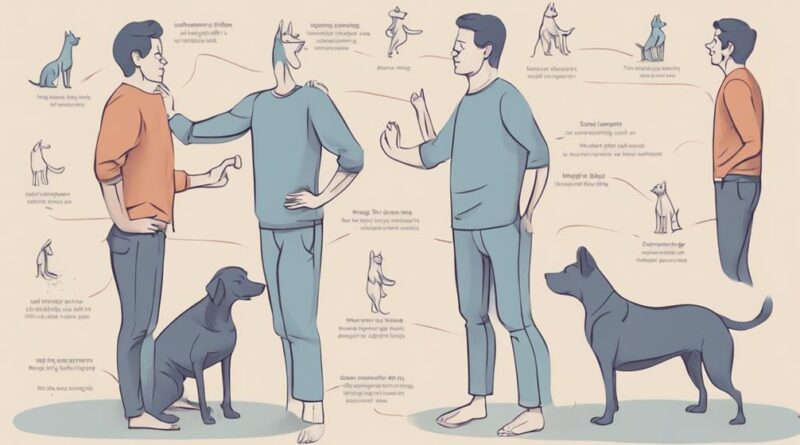Professional Guide to Understanding Dog Psychology
Imagine observing a dog who suddenly starts avoiding certain areas in the house or growls when approached while eating. Understanding the underlying psychology behind such behaviors is crucial for effective dog training and handling.
By unraveling the complexities of canine emotions and instincts, you can build a stronger bond with your furry companion and address behavioral issues more compassionately.
Mastering the intricacies of dog psychology can not only enhance your relationship with your pet but also create a harmonious environment for both of you to thrive.
Canine Communication Signals
When observing dogs, pay close attention to their body language to understand their communication signals. Dogs convey a lot through their body language cues, such as wagging tails, raised fur, and relaxed postures.
A wagging tail doesn't always mean a dog is happy; the position and speed of the wag can indicate different emotions. For instance, a high, fast wag usually signifies excitement, while a low, slow wag might indicate insecurity or fear.
Vocalizations in dogs also play a crucial role in communication. Barks, whines, growls, and howls all carry different meanings. A sharp, short bark could signal alertness or warning, while a prolonged, high-pitched whine might express anxiety or a desire for attention. Growls can range from playful to aggressive, depending on the context and tone.
Understanding these body language cues and vocalizations can help you decipher what your furry friend is trying to communicate, strengthening the bond between you.
Pack Hierarchy Dynamics
To comprehend pack hierarchy dynamics among dogs, observe their interactions and behaviors closely. Understanding the dynamics of dominance and submission within a dog pack can provide insights into their social structure.
Here are some key points to consider:
- Leadership: Dogs naturally establish a hierarchy within their pack, where one or more individuals take on leadership roles.
- Followership: Other dogs in the pack typically follow the lead of the dominant individuals, showing submission through body language and behavior.
- Dominance: Dominant dogs often display assertive behaviors such as standing tall, making direct eye contact, and using vocalizations to convey their status.
- Submission: Submissive dogs exhibit behaviors like lowering their body, avoiding direct eye contact, and offering their neck or belly to more dominant pack members.
- Hierarchy: The pack hierarchy is fluid and can change based on various factors like age, health, and individual personalities.
Understanding these dynamics can help you better interpret your dog's behavior and maintain a harmonious relationship within your own 'pack.'
Canine Social Behavior Patterns
Exploring canine social behavior patterns reveals the intricate ways in which dogs interact within their packs. Pack bonding is a crucial aspect of a dog's social behavior, as it establishes a sense of unity, cooperation, and hierarchy within the group. Dogs exhibit pack bonding through various activities such as grooming each other, playing together, and even sleeping in close proximity.
Socialization techniques play a vital role in shaping a dog's behavior towards other canines and humans. Early socialization with different dogs of various breeds, sizes, and ages helps in developing proper social skills and reducing the likelihood of aggressive behavior. Additionally, exposing dogs to different environments, sounds, and stimuli during their critical socialization period (usually between 3 to 14 weeks of age) can help them become well-adjusted and confident adults.
Understanding and recognizing these canine social behavior patterns can aid in fostering healthy relationships between dogs and their human companions, as well as ensuring harmonious interactions with other dogs they encounter.
Understanding Canine Aggression Triggers
Understanding canine aggression triggers requires a keen awareness of subtle cues in a dog's body language and behavior. It's essential to recognize the signs that may lead to aggressive behavior to prevent potential incidents. Here are some key aggression triggers to be mindful of:
- Fear Aggression: Dogs may become aggressive when they feel threatened or scared. Understanding what triggers fear in your dog can help you avoid confrontational situations.
- Territorial Aggression: Dogs may display aggression to protect their territory. Recognizing territorial triggers can help manage and prevent aggressive behavior towards intruders or other animals.
- Resource Guarding: Dogs can exhibit aggression when they feel their resources like food, toys, or sleeping areas are being threatened. Being aware of resource guarding triggers can prevent conflicts.
- Social Aggression: Dogs may show aggression towards other dogs or people due to social hierarchies or competition. Understanding social aggression triggers can help prevent aggressive interactions.
- Body Language Cues: Paying attention to your dog's body language, such as stiff posture, growling, or raised fur, can help you identify potential aggression triggers before they escalate.
Canine Anxiety and Stress Indicators
Recognizing signs of anxiety and stress in dogs is crucial for their well-being and behavior management. Dogs may display various indicators when feeling anxious or stressed, such as excessive panting, pacing, trembling, or avoiding eye contact.
To help your furry friend cope with these emotions, consider implementing relaxation techniques and coping mechanisms. Providing a safe and quiet space, engaging in soothing activities like massage or gentle grooming, or playing calming music can all aid in reducing your dog's stress levels.
In addition to these relaxation techniques, behavioral therapy and holistic approaches can also be beneficial. Behavioral therapy focuses on modifying your dog's responses to stress triggers through positive reinforcement and desensitization techniques. Holistic approaches, such as aromatherapy, acupuncture, or specialized diets, can complement traditional methods to promote overall well-being and reduce anxiety in dogs.
Role of Play in Dog Psychology
When observing your dog's behavior, the role of play emerges as a significant aspect in understanding their psychology and well-being. Play isn't just a fun activity for dogs; it serves a crucial purpose in their mental and emotional development.
Here are some key points to consider:
- Play therapy: Engaging in play helps dogs release pent-up energy and reduce stress, promoting a sense of relaxation and well-being.
- Behavioral enrichment: Play provides mental stimulation, preventing boredom and destructive behaviors that may arise from lack of mental engagement.
- Socialization: Through play, dogs learn important social skills such as communication, cooperation, and understanding of social cues.
- Bonding: Playing with your dog strengthens the bond between you, fostering trust and enhancing your relationship.
- Physical health: Play helps maintain your dog's physical health by keeping them active, agile, and maintaining a healthy weight.
Incorporating play into your dog's daily routine isn't just about fun; it's a vital component of their overall psychological and emotional wellness.
Canine Learning and Training Principles

Engage with your dog using effective training principles to facilitate their learning and development. Positive reinforcement is a key aspect of canine learning, where you reward your dog for exhibiting desired behaviors. This method reinforces good behavior by associating it with a pleasant outcome, encouraging the dog to repeat the behavior.
On the other hand, behavior modification involves addressing and correcting unwanted behaviors through various techniques. By understanding the reasons behind your dog's behavior, you can implement strategies to modify it effectively.
Consistency is crucial in training your dog. By setting clear expectations and boundaries, you help your dog understand what's expected of them. Regular training sessions that are short and engaging can be more effective than sporadic long sessions. Through repetition and practice, your dog will solidify their learning and behaviors.
Remember to be patient and understanding during the training process. Dogs thrive on positive interactions and respond well to a calm and encouraging environment. By applying positive reinforcement and behavior modification techniques consistently, you can help your dog learn and grow in a supportive manner.
Applying Dog Psychology in Training Sessions
To enhance your dog's training experience, understanding their psychology is essential for effective communication and behavior shaping. When applying dog psychology in training sessions, it's crucial to focus on positive reinforcement techniques and behavior modification. This approach helps strengthen desired behaviors while minimizing unwanted ones. Additionally, incorporating bonding exercises into your training routine is vital for relationship building and creating a strong connection with your furry companion.
Here are some key strategies to consider:
- Use positive reinforcement techniques such as treats and praise to reward good behavior promptly.
- Implement behavior modification methods consistently to address any problematic behaviors.
- Engage in bonding exercises like interactive play and grooming to strengthen your bond with your dog.
- Practice relationship building by spending quality time together, going for walks, and exploring new environments.
- Stay patient and persistent throughout the training process to achieve long-lasting results and a harmonious relationship with your dog.
Frequently Asked Questions
How Can I Help My Dog Overcome Separation Anxiety?
To help your dog overcome separation anxiety, try behavioral training and desensitization techniques. Identify triggers like departure cues and work on behavior modification.
Gradually increase the time you're away to build your dog's confidence. Provide interactive toys or treats before leaving. Seek professional guidance if needed for a tailored plan.
What Are Some Common Misconceptions About Dominance in Dogs?
When it comes to dominance in dogs, there are some common misconceptions. People often believe that dogs operate solely based on pack hierarchy and the alpha role. However, this view oversimplifies the complex nature of dog behavior.
Dogs are individuals with unique personalities and experiences. Dominance isn't always the root cause of behavioral issues and should be approached with a more nuanced understanding.
How Can I Prevent Resource Guarding Behavior in My Dog?
To prevent resource guarding behavior in your dog, use positive reinforcement and consistent boundaries. Start by teaching your dog that good things happen when people approach their resources. Reward calm behavior around food, toys, or other items.
Create a safe environment where they feel secure. Set clear rules and be consistent in enforcing them. With patience and training, you can help your dog feel more comfortable sharing resources without guarding them.
Is It Possible to Train an Adult Dog That Was Not Properly Socialized as a Puppy?
Yes, it's possible to train an adult dog that wasn't socialized properly as a puppy. Adult rehabilitation and behavior modification techniques can help address socialization issues in older dogs.
By using positive reinforcement, patience, and consistency, you can gradually expose your dog to new experiences and teach them how to interact with other dogs and people.
With dedication and the right approach, adult dogs can still learn and adapt to new social situations.
What Are Some Effective Ways to Build Trust and Strengthen the Bond With My Dog?
To build trust and strengthen your bond with your dog, use positive reinforcement and be consistent in your interactions. Communicate clearly with your pet and show patience as you work together.
Spend quality time engaging in activities your dog enjoys, like play or walks. Be reliable and make sure to establish routines.
Conclusion
Now that you have a better understanding of dog psychology, you can enhance your bond with your furry friend and improve their overall well-being.
By recognizing their communication signals, understanding their social behavior patterns, and addressing aggression triggers and anxiety, you can create a positive environment for your dog.
Remember to incorporate play and positive reinforcement in your training sessions to effectively apply these principles of dog psychology.
Keep up the good work and enjoy your time with your pup!
